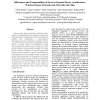Free Online Productivity Tools
i2Speak
i2Symbol
i2OCR
iTex2Img
iWeb2Print
iWeb2Shot
i2Type
iPdf2Split
iPdf2Merge
i2Bopomofo
i2Arabic
i2Style
i2Image
i2PDF
iLatex2Rtf
Sci2ools
AINA
2009
IEEE
2009
IEEE
Differences and Commonalities of Service-Oriented Device Architectures, Wireless Sensor Networks and Networks-on-Chip
Device centric Service-oriented Architectures have shown to be applicable in the automation industry for interconnecting manufacturing devices and enterprise systems, thus, establishing a comprehensive, heterogeneous service architecture. A similar scenario can also be found in the domain of integrated circuits where a growing number of components is being interconnected by a network inside a single chip. Thus, service-oriented concepts seem promising to be used abstract composition of on-chip components. However, tight constraints on power consumption and performance have to be considered when a compound service shall be executed. In this paper will be shown that the consideration of such constraints is profoundly beneficial. From this starting point, we argue that such an approach can also be useful in the context of wireless sensor networks with its large number of distributed, heterogeneous sensor nodes and limited energy sources.
AINA 2009 | Centric Service-oriented Architectures | Computer Networks | Heterogeneous Sensor Nodes | Heterogeneous Service Architecture |
| Added | 09 Jul 2010 |
| Updated | 09 Jul 2010 |
| Type | Conference |
| Year | 2009 |
| Where | AINA |
| Authors | Guido Moritz, Claas Cornelius, Frank Golatowski, Dirk Timmermann, Regina Stoll |
Comments (0)

